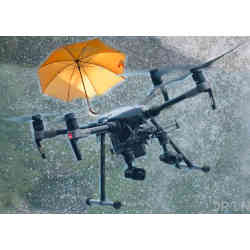
A remarkable video released by the National Center of Meteorology of the United Arab Emirates (UAE) shows a rarity: a heavy downpour of rain in the desert.
However, the rain isn't the rare part (although the UAE gets just about four inches of rain per year). What's rare is the rain's source: the downpour was caused by drones.
Unmanned drones flew into a bank of clouds, then used electricity to cause the droplets locked in the clouds to fall. The result was a man-made downpour.
The project is based on research from the U.K.'s University of Reading, where researchers modeled and measured how rain droplets in a cloud behave when electrically charged. Theoretically, if two droplets have the same charge, they may be attracted to each other and merge; the new, bigger droplet may then be heavy enough to fall. Charge enough droplets and you can, in theory, induce rainfall.
The footage released by the UAE suggests this type of weather control works in practice.
It is the latest effort at "cloud seeding," which is the practice of inducing rain by dispersing material into the clouds to encourage condensation. Cloud seeding has been practiced for the last 50 years, says Daniel Rosenfeld, a professor of atmospheric sciences at Hebrew University, Jerusalem, and an expert in weather modification. Historically, a number of means have been used to induce rain in clouds, including dropping salt into them, a process the UAE already uses for cloud seeding.
Drones armed with electrical charges are just the latest in a string of attempts to coax rain from the sky via cloud seeding. This attempt, funded by the United Arab Emirates Rain Enhancement Program (UAE REP), may be more significant than past efforts, because cloud seeding runs into some big obstacles that the drone program is trying to solve, says Rosenfeld.
It is difficult to measure how well cloud seeding methods work, since you never know how much rain would have fallen without the seeding. It's also hard to tell which clouds are ripe for seeding in the first place, and even if you find clouds bearing enough droplets, seeding them in a timely fashion is not easy.
"The UAE REP program is a serious effort to address all these questions in a scientifically sound way," says Rosenfeld. As part of the program, the UAE government gave research teams at the University of Reading one of nine grants totaling $15 million.
The Reading researchers used their funding across multiple projects that led to the drone cloud seeding.
First, they simulated the behavior of water droplets in clouds. Researchers Torsten Auerswald and Maarten Ambaum used a technique called "ABC flow" to model how droplets behave. Because the technique simulates motion using far less computing power than other methods, they also were able to simulate how electrical charges could influence droplets, providing a clear, measurable picture of how electric-charge cloud seeding could work.
Then, another team at the university (of which Ambaum was also a part) spent a year measuring electrical charge in fog layers above the UAE. They found that rain droplets in the UAE's fog layers were much smaller than those measured above more-temperate sites in Finland and the United Kingdom, suggesting that charging droplets could actually induce rainfall.
Finally, the teams tested their theories by launching drones equipped with instruments to induce electric charges in the sky near Dubai, producing the incredible video of a rainstorm in the desert. The results of the drone program will be evaluated in the near future to determine whether the approach merits more funding.
Rosenfeld is impressed with the project, but cautions that more work needs to be done on weather modification through cloud seeding, by drone or any other means.
"The limiting factor is the identification of seedable clouds in a timely and actionable fashion," says Rosenfeld.
Simulations of cloud properties and cloud measurements like those done by the University of Reading team are a good start, but our physical understanding of cloud behavior needs to be complemented with real-time satellite and radar observations, says Rosenfeld. Better, faster cloud identification would allow drones to be automatically directed towards the most 'seedable' clouds.
One promising avenue to make this a reality is artificial intelligence. "AI is the proper tool for relating the radar and satellite observations to the cloud properties of interest," says Rosenfeld.
AI systems are beginning to become robust enough to deliver critical insights on cloud behavior and composition in real time. These systems are also being increasingly used for short-term prediction of cloud behavior, which is necessary to direct drone-based cloud seeding.
Logan Kugler is a freelance technology writer based in Tampa, FL, USA. He has written for over 60 major publications.



Join the Discussion (0)
Become a Member or Sign In to Post a Comment